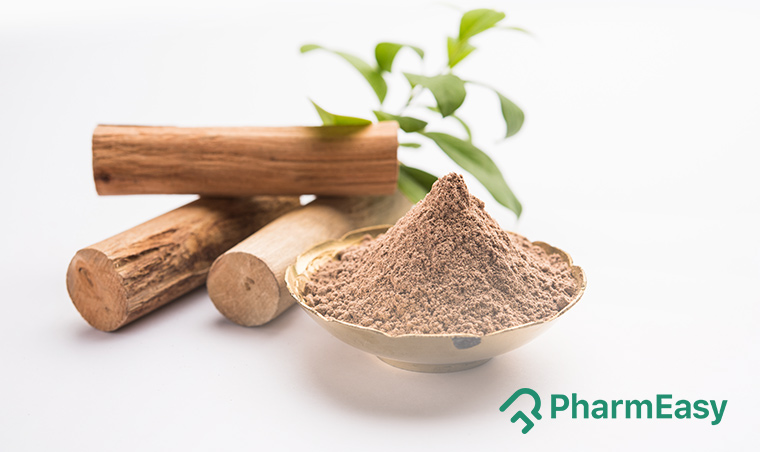Sandalwood: Uses, Benefits, Side Effects & More!
By Dr Smita Barode +2 more

Get,

to manage your symptom
Get your,


4 Cr+ families
benefitted

OTP sent to 9988776655



You’ve successfully subscribed to receive
doctor-approved tips on
Whatsapp

Get ready to feel your best.

Hi There,
Download the PharmEasy App now!!


Register to Avail the Offer
Send OTPBy continuing, you agree with our Privacy Policy and Terms and Conditions

Hi There,
Sign up on PharmEasy now!!
Trusted by 4 crore+ families

OTP sent to 9988776655



You have unlocked 25% off on medicines




Code: NU25
By Dr Smita Barode +2 more
Table of Contents
Sandalwood refers to the wood (heartwood) from tree species belonging to the family Santalaceae and genus Santalum1. The wood from these trees has a characteristic aromatic fragrance. There are many species of trees that fall under this genus, of which the East Indian sandalwood (Santalum album) and Australian sandalwood (S. spicatum) are the most prominent.
These are the two species that are mainly used to produce sandalwood oil. The Indian sandalwood grows up to 30 feet in height and is a small evergreen tree the wood is fragrant with yellow to maroon flowers, oval leaves and dark red-black fruit2.

It is a tropical tree found all over the country, with the majority growing in Karnataka and Tamil Nadu. The other states where they grow are Maharashtra, Rajasthan, Uttar Pradesh, Bihar, Kerala, Andhra Pradesh, Orissa, Manipur, and Madhya Pradesh1.
Did you know?
It is known by different names in different vernacular languages like:
The Indian sandalwood, commonly called chandana in Sanskrit, has been in use for ages in India. It is considered a sacred part of Hindu customs. Usually, the oil extracted from the wood is used.
The beneficial properties of sandalwood are listed in the section below.
I recently came across a study that says that, according to preliminary research, ingesting a combination of white sandalwood, tamarind, and neem may help vaginal discharge and pain in women having a vaginal infection. Sandalwood is known for its anti-inflammatory and soothing properties.
Dr. Siddharth Gupta, B.A.M.S, M.D (Ayu)
The sandalwood is the central part of the tree with a characteristic fragrance. The oil extracted from this sandalwood is referred to as the East Indian sandalwood oil and is used in different health conditions. Also, the wood can be powdered and used as well5.

I suggest if you are on lithium, see your doctor before using sandalwood products. You might need to adjust your lithium dosage. Red sandalwood may act as a “diuretic” or as a water pill. Consuming red sandalwood might impair the body’s ability to eliminate lithium. Lithium levels may rise as a result, which may have negative side effects19.
Dr. Rajeev Singh, BAMS

It may show some memory-enhancing potential, sedative and calming effect, and anti-inflammatory actions, which have been proven in animal studies. Thus, it has potential use in sleeping disorders, anxiety, and Alzheimer’s disease, for which further research is needed7. Since data for its effectiveness on humans is insufficient, we further need to consult a doctor before using sandalwood for these conditions.

The chemical α-Santalol present in sandalwood has anti-cancer properties, as evidenced by animal and cell culture studies. Thus, it has potential use in the management of skin tumours, which must be further investigated before its use in humans8. Moreover, cancer should be diagnosed and treated by a qualified doctor. Kindly consult a doctor for better advice.

An ulcer is a break in the lining of the stomach or intestine. Studies have shown that sandalwood has anti-inflammatory and anti-bacterial properties. The sandalwood oil may be effective against H. pylori, a bacterium responsible for gastric ulcer development. Thus, the oil extract of sandalwood may be used in the treatment of stomach and intestinal ulcers7. Ulcers are serious and must be properly treated by a doctor.

It is proven that the oil extract of sandalwood has anti-bacterial, anti-fungal, and anti-viral activity in studies. Its anti-bacterial action might make it useful in treating ulcers caused by H. pylori bacterium and skin acne caused by staphylococcal and streptococci bacteria, while its anti-viral actions might make it useful in treating skin warts, blemishes, and Molluscum contagiosum, which is an infection caused by a poxvirus.
Scabies is a skin infection caused by a mite, causing skin burrows, itching, red rashes, and inflammation. The most common site affected is the skin webs between the fingers. Sandalwood due to antiseptic, anti-microbial, and anti-inflammatory actions, might make it useful in reducing the redness, itching, and inflammation that develops in scabies7,9. Kindly consult a doctor for better advice before using sandalwood for its benefits.

Sandalwood has demonstrated cardioprotective effects by reducing heart tissue damage, antioxidant, lipid-lowering, and blood sugar lowering actions, which need more investigation in humans7. This information is insufficient and require more human trials to suggest the uses of sandalwood. Therefore, people should speak to their concerned doctors and only have sandalwood if prescribed.

Sandalwood has blood sugar lowering properties and antioxidant actions which favour its use in diabetes, but further investigation is needed7.

Sandalwood has antipyretic action that is, it reduces body temperature and can be used for treating fever. This property is supported by various animal studies7.
Though there are studies showing the potential use of sandalwood in various conditions, but these are insufficient and there is a need for further studies to establish the true extent of benefits of sandalwood on human health.
I suggest monitoring your diabetic medication dosage while consuming sandalwood. Blood sugar levels may be lowered by intake of red sandalwood extract. When used with diabetic treatments, red sandalwood extract may cause your blood sugar to drop too low. Keep a watchful eye on your blood sugar20.
Dr. Smita Barode, B.A.M.S, M.S.
Sandalwood is used in the following ways
You must consult a qualified doctor before taking any herbal supplements. Do not discontinue or replace an ongoing treatment of modern medicine with an ayurvedic/herbal preparation without consulting a qualified doctor.
Sandalwood taken by mouth in amounts used in food is most likely safe, but its prolonged use is possibly unsafe. The most common side effects are as follows:
However, if any such reaction is noticed on using it, seek immediate medical attention. Consult your Ayurvedic physician who has prescribed it to you; they will be able to identify the cause and treat it effectively.
Also Read: Kulthi Dal: Uses, Benefits, Side Effects & More!
The following precautions and warnings are to be taken into consideration when sandalwood is being used:

According to animal studies, sandalwood oil might affect the foetus when given to pregnant females. Therefore, it should not be taken against the advice of the consulting gynaecologist13.
Also Read: Ramphal: Uses, Benefits, Side Effects & More

Sandalwood should be avoided by people suffering from kidney diseases as it can cause kidney damage12.
Therefore, if you are on any medication and want to take sandalwood you must consult your doctor as they would guide you best on this.
Also Read: Stone Flower (Kalpasi): Uses, Benefits, Side Effects & More!
Yes, it is used for treating acne due to its anti-bacterial and anti-inflammatory properties7.
The term sandalwood refers to the wood (heartwood) of the tree species belonging to the family Santalaceae and genus Santalum1.
Yes, it has many benefits when applied to the skin. It is used as a cosmetic to prevent wrinkles, reduce acne, dark spots, and heal wounds. It is also useful in skin conditions like psoriasis, eczema, Molluscum contagiosum, and scabies7. You must consult an ayurvedic physician or dermatologist.
Sandalwood oil is added to food as a preservative or used as a flavouring agent while cooking10.
Sandalwood is safe and can be used daily. It is to be avoided if you are allergic, as you can develop contact dermatitis (a skin rash that is caused due to contact with a particular substance)11. You must only use it if prescribed by doctors.
It is useful for the management of different skin conditions. It is also useful in case of infections like UTI, vaginitis, bronchitis, and gonorrhoea. It is also used for ulcer treatment. Sandalwood also has potential use as an antipyretic, sedative, and for the management of Alzheimer’s, heart disease, and cancer, for which further research is required7,9. However, we need more scientific support and more studies on humans are also required to suggest the uses of sandalwood for these conditions. Consult an Ayurvedic physician for better advice.
There are many species of trees that fall under this genus, of which the Indian sandalwood (Santalum album) and Australian sandalwood (S. spicatum) are the most prominent2.
Sandalwood refers to the wood (heartwood) from tree species belonging to the family Santalaceae and genus Santalum1 while cedarwood belongs to the genus Cedrus consisting of coniferous trees belonging to the family Pinaceae14.
Tree species belonging to the family Santalaceae are called sandalwood1. Rosewood (Aniba rosaeodora) belongs to the family Lauraceae15.
Sandalwood refers to the wood (heartwood) from tree species belonging to the family Santalaceae and genus Santalum1. while teakwood (Tectona grandis) belongs to the family Lamiaceae16.
Sandalwood refers to the wood (heartwood) from tree species belonging to the family Santalaceae and genus Santalum. There are many species of trees that fall under this genus, of which the Indian sandalwood (Santalum album) and Australian sandalwood (S. spicatum) are the most prominent. The Indian sandalwood is also called white sandalwood1,2,17. While the tree Pterocarpus Santalinus is referred to as red sandalwood18.
Disclaimer: The information provided here is for educational/awareness purposes only and is not intended to be a substitute for medical treatment by a healthcare professional and should not be relied upon to diagnose or treat any medical condition. The reader should consult a registered medical practitioner to determine the appropriateness of the information and before consuming any medication. PharmEasy does not provide any guarantee or warranty (express or implied) regarding the accuracy, adequacy, completeness, legality, reliability or usefulness of the information; and disclaims any liability arising thereof.
Links and product recommendations in the information provided here are advertisements of third-party products available on the website. PharmEasy does not make any representation on the accuracy or suitability of such products/services. Advertisements do not influence the editorial decisions or content. The information in this blog is subject to change without notice. The authors and administrators reserve the right to modify, add, or remove content without notification. It is your responsibility to review this disclaimer regularly for any changes.
Comments

Leave your comment...
You may also like
Comments